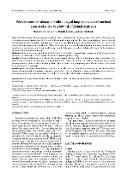Percutaneous transthoracic needle biopsy of lung lesions is a safe method associated with a very low risk of pleural recurrence

Publication date
2025Published in
Biomedical PapersVolume / Issue
169 (1)ISBN / ISSN
ISSN: 1213-8118ISBN / ISSN
eISSN: 1804-7521Metadata
Show full item recordCollections
This publication has a published version with DOI 10.5507/bp.2024.030
Abstract
AIM: Percutaneous transthoracic needle biopsy (PTNB), an alternative to bronchoscopic confirmation of lung lesions, is today being associated with a risk of pneumothorax and hemorrhage. Further, there are no data on the possible risk of malignant disease spreading to the pleura at the site of the PTNB. Previous studies have dealt with this risk in stage I non-small cell lung cancer only. The aim of this study was thus to assess the risk of pleural recurrence for all types of lung lesions. Secondary objectives included assessment of diagnostic yield and safety with respect to the incidence of pneumothorax and hemorrhage. METHODS: Clinical data of all patients from the University Hospital in Pilsen who had undergone PTNB of lung lesions between 1.1.2018 and 31.12.2022 were included in this retrospective study. RESULTS: Following PTNB, ipsilateral pleural effusion occurred in 4.8% of patients without prior pleural infiltration. The effusion was confirmed as malignant in one patient (0.7%). Diagnostic yield of the method was 86.6%. We recorded pneumothorax or hemorrhage in the lung parenchyma or pleural space requiring medical intervention in 3.4% and 1.1% of patients, respectively. CONCLUSION: In our study, percutaneous transthoracic needle biopsy of lung lesions showed high sensitivity and low degree of acute complications requiring an invasive solution. The risk of pleural recurrence after a biopsy was very low. Consequently, we continue to consider this method to be an alternative to bronchoscopy biopsies.
Keywords
NSCLC, bleeding into the lung parenchyma, percutaneous transthoracic needle biopsy, pneumothorax, recurrence
Permanent link
https://hdl.handle.net/20.500.14178/2723License
Full text of this result is licensed under: Creative Commons Uveďte původ 4.0 International







